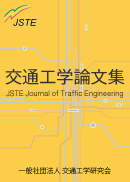Volume 9, Issue 3
Displaying 1-5 of 5 articles from this issue
- |<
- <
- 1
- >
- >|
Paper (1) Fundamental/Applied Academic Research
-
2023Volume 9Issue 3 Pages 1-10
Published: April 01, 2023
Released on J-STAGE: April 01, 2023
Download PDF (2489K) -
2023Volume 9Issue 3 Pages 11-23
Published: April 01, 2023
Released on J-STAGE: April 01, 2023
Download PDF (5382K) -
2023Volume 9Issue 3 Pages 24-36
Published: April 01, 2023
Released on J-STAGE: April 01, 2023
Download PDF (1253K) -
2023Volume 9Issue 3 Pages 37-46
Published: April 01, 2023
Released on J-STAGE: April 01, 2023
Download PDF (936K)
Paper (2) Case Study/Survey Research/System Development
-
2023Volume 9Issue 3 Pages 47-60
Published: April 01, 2023
Released on J-STAGE: April 01, 2023
Download PDF (2871K)
- |<
- <
- 1
- >
- >|
